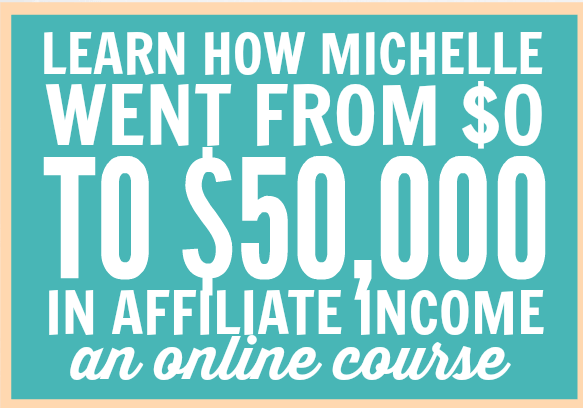If you’ve spent much time reading income reports on blogs, you know that there are TONS of bloggers out there earning a full-time income blogging. Many of them even earn five to six figures each month!
Meanwhile, you’re working your butt off and you’re hardly making any money at all.
Maybe you’re only earning enough to buy yourself a cup of coffee each month, or perhaps you’ve hit a certain dollar amount (say, $500) each month but can’t seem to increase your income.
It’s like you’ve hit an invisible ceiling and you just can’t break through.
I’ve been there.
It’s SO frustrating when you spend all of your time and energy building up your blog only to get nowhere…while other people are somehow earning $100,000 PER MONTH!
I’ve learned a lot about blogging over the past few years, and I’ve learned that there are a few main reasons why a blog isn’t making money.
Not Enough Traffic
Traffic certainly isn’t everything, but it is VERY important. It’s extremely difficult to make money with a blog that has a tiny audience.
If you have a lot of traffic, you can charge more money for sponsored posts, it’ll be easier to make money with ads (which are typically pay per click), more people will likely click on your affiliate links, and you’ll have a larger potential customer base for products like eBooks or online courses.
So… how do you get more traffic?
There are a lot of strategies for gaining traffic (like guest posting on other websites, optimizing SEO for Google, using Facebook ads), but the single most effective way to generate massive traffic (for free) is with Pinterest.
Pinterest, unlike other social media platforms, is a search engine. Users go to Pinterest specifically to find content. There’s less competition on Pinterest than there is on Google, so it’s easier to gain traffic through Pinterest.
This is why I recommend focusing your time and energy on Pinterest.
If you haven’t had much luck with Pinterest, here are several possible reasons:
- Your pins are ugly. #sorry
- You aren’t using a business account or rich pins.
- You don’t understand how Pinterest SEO works.
- You aren’t taking advantage of group boards.
- You haven’t used PinGroupie.
- Your pins have boring titles.
- Your pin titles don’t solve a problem that your readers have.
- You’re wasting your time pinning manually instead of using a helpful scheduling tool like Tailwind.
If you want to learn how to maximize your traffic with Pinterest, sign up for Pinterest Traffic Avalanche! It is the BEST Pinterest class out there, hands down.
Alex and Lauren, the creators of six figure blogs Avocadu (a health and wellness blog) and Create and Go (about blogging), are extremely thorough and I was very impressed with quality of the class.
PTA teaches you everything you need to know to be successful with Pinterest. You’ll learn how to design beautiful pins, how to create viral blog post titles, how to use Tailwind successfully, how to maximize reach with group boards, how to rock Pinterest SEO, and so much more!
Sign up today to start generating massive traffic to your blog!
No Monetization Strategy
High traffic isn’t enough if you don’t have a strategy for monetizing that traffic. How do you plan to make money?
Here are some of the most common ways bloggers make money:
- Sponsored posts
- Affiliate marketing
- Ads
- Digital products (printables/worksheets, eBooks, online courses)
- Freelance writing
If affiliate income is your focus, learn everything you can about affiliate marketing.
I took Michelle Shroeder Gardner’s class Making Sense of Affiliate Marketing and my affiliate income skyrocketed after taking the class! Michelle makes over $50,000 per month with affiliate marketing alone.
The class is SO helpful and teaches you everything you need to know to be successful with affiliate marketing. Sign up today to become an affiliate marketing whiz!
Ignoring the List
One popular way to monetize a blog is with an email list. The strategy looks like this:
Drive massive traffic to blog (using Pinterest) -> Get readers to sign up for email list -> sell to email list
People who join your email list are the people who are the most interested in your content. These are your most loyal followers.
I get annoyed when my email inbox is always full, so I only join an email list if I REALLY like the content.
So…how do you get readers to sign up for your email list?
There are numerous different strategies for this. The most effective two I’ve found are:
- Creating calls to action in blog posts.
- Offering a “freebie” (a digital download) to readers who subscribe to your email list.
Here’s an example of a call to action in a blog post.
If your blog post is long, you could include 2-3 of these (one near the beginning, another toward the middle, and a third at the end). For a shorter blog post, it makes sense to only use 1 or 2 CTA’s.
Offering a freebie is another smart way to get readers to subscribe. Giving them something useful provides them with an incentive to sign up.
For example, I run a personal finance blog, so I offer the following freebies:
- How to Create a Budget + Budgeting Worksheet
- 30 Day No Spend Challenge
- Meal Planner
- Wedding Budget Worksheet
What particular freebies you should offer depends on the niche of your blog. If you run a health and wellness blog, you might have a freebie called “30 Days of Yoga for Fat Loss” or something similar. A blog about homemaking might offer a cleaning checklist or schedule.
I highly recommend offering freebies, but be careful about how you handle these. Because of the GDPR, websites (with readers in Europe) have specific rules that need to be followed regarding consent for being subscribed to email lists.
Once you’ve built up an email list, you can sell to them. “Selling” could mean selling your own products (digital products, eBooks, courses) or it could be selling others’ products through affiliate links.
I send out an email to my subscribers about once to twice per month, and I often include (affiliate) links to useful money saving resources (two examples are Ibotta and Ebates).
Growing your email list is important because a larger list means more potential sales. Conversion rates are often low (think 1-2%). If only 10 people click on an affiliate link in an email, maybe 0-2 of them will purchase something. Alternatively, if 10,000 people click on an affiliate link, 100 people might make a purchase.
Let’s say you earn $75 per affiliate sale. In the first example, you’d earn $150 at most. In the second, you’d earn $7,500.
This shows why it’s crucial to have high traffic and a large email list. The more traffic you have, the more potential customers you have.
That being said, traffic is NOT the only thing that matters. It’s important to tailor your message toward your audience and to give them what they want.
If you’re writing about all sorts of different topics, your niche might be too large and your audience won’t necessarily be interested in what you have to sell.
Work on increasing your traffic, but remember that traffic isn’t everything.
Making Money Blogging
If you’re struggling to make as much money blogging as you’d like to, make sure to:
- Dedicate time to learn Pinterest thoroughly. This is the best way to generate massive traffic for free.
- Develop a solid monetization strategy.
- Pay close attention to your email list. Don’t ignore this crucial step!
What do you find most frustrating about making money blogging?




Recent Comments